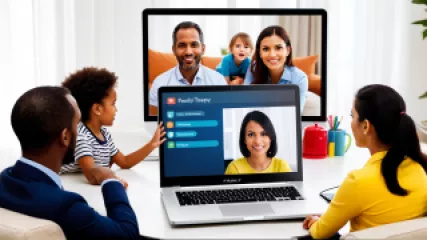Research Insights on Virtual Family Therapy for Conflict Resolution
Family conflict is a ubiquitous part of human relationships, often arising from differences in values, expectations, and communication styles. The advent of virtual family therapy has introduced new avenues for addressing these conflicts, offering unique strategies and emotional support that can foster healthier family dynamics. This article delves into the research insights on virtual family therapy for conflict resolution, providing an in-depth summary of findings from various studies and expert opinions.
The Evolution of Family Therapy: From In-Person to Virtual
Family therapy has long been a cornerstone in addressing familial conflicts and fostering healthy family dynamics. Traditionally conducted in-person, these therapeutic sessions provided a safe space for families to discuss and resolve their issues under the guidance of a trained therapist. However, with technological advancements and the increasing accessibility of the internet, virtual family therapy has emerged as a viable alternative.
The Rise of Virtual Family Therapy
Virtual family therapy, also known as online family therapy, leverages digital platforms to facilitate therapy sessions. This modality gained significant traction during the COVID-19 pandemic when social distancing measures necessitated remote interactions. According to Psychology Today, there was a 65% increase in the use of virtual therapy services from 2019 to 2021.
The convenience and accessibility of virtual family therapy have made it an attractive option for many families. It eliminates geographical barriers, reduces travel time, and allows for more flexible scheduling. Moreover, it provides a level of comfort and privacy that some individuals may find conducive to open communication.
Research Insights on the Effectiveness of Virtual Family Therapy
A growing body of research supports the efficacy of virtual family therapy in resolving family conflicts. Studies have shown that this modality can be as effective as traditional in-person therapy, with several additional benefits.
Comparative Studies
A study published in the Journal of Marital and Family Therapy compared the outcomes of virtual and in-person family therapy sessions. The researchers found no significant difference in the efficacy of the two modalities. Both groups reported similar levels of improvement in family communication, conflict resolution skills, and overall satisfaction with the therapy process.
"Our findings suggest that virtual family therapy can be a viable alternative to traditional in-person therapy, particularly for families facing logistical challenges or those who prefer the comfort and flexibility of online sessions." — Journal of Marital and Family Therapy
Accessibility and Convenience
One of the most significant advantages of virtual family therapy is its accessibility. For families living in rural or remote areas, accessing in-person therapy services can be challenging. Virtual therapy bridges this gap, providing access to qualified therapists regardless of location. Furthermore, it offers scheduling flexibility, making it easier for families to find suitable times for sessions without disrupting their daily routines.
Benefits for Specific Populations
Research has also highlighted the benefits of virtual family therapy for specific populations. For instance, families with members who have physical disabilities or chronic illnesses may find it easier to participate in virtual sessions. Similarly, families with young children can benefit from the reduced need for childcare arrangements, as sessions can be conducted from the comfort of their own homes.
Strategies for Resolving Family Conflicts in Virtual Therapy
Effective virtual family therapy employs various strategies to address and resolve family conflicts. These strategies are tailored to the unique dynamics and needs of each family, ensuring a personalized approach to conflict resolution.
Communication Enhancement Techniques
Improving communication is often a primary focus in family therapy. Virtual family therapists use several techniques to enhance communication among family members:
- Active Listening: Encouraging family members to listen actively and empathetically to one another, promoting understanding and reducing misunderstandings.
- I-Statements: Teaching family members to express their feelings and concerns using "I" statements rather than accusatory "you" statements, which can reduce defensiveness and promote constructive dialogue.
- Reflective Listening: Helping family members reflect on what they have heard, ensuring that they accurately understand each other's perspectives.
Conflict Resolution Skills
Developing conflict resolution skills is another critical aspect of virtual family therapy. Therapists employ various strategies to help families navigate conflicts effectively:
- Problem-Solving Techniques: Guiding families through structured problem-solving processes, enabling them to identify the root causes of conflicts and develop mutually agreeable solutions.
- Negotiation and Compromise: Teaching family members negotiation skills and the importance of compromise in resolving conflicts.
- Emotional Regulation: Helping family members manage their emotions constructively, reducing the likelihood of escalations during conflicts.
Role-Playing and Behavioral Rehearsal
Role-playing and behavioral rehearsal are powerful tools used in virtual family therapy to practice and reinforce conflict resolution skills. By simulating real-life scenarios, family members can develop and refine their abilities to handle conflicts effectively. Research indicates that these techniques can significantly enhance the transfer of skills from therapy sessions to real-world situations.
Parenting Coaching for Conflict Resolution
Parenting coaching is a specialized form of family therapy that focuses on equipping parents with the skills and strategies needed to resolve conflicts within the family unit. This approach recognizes the pivotal role that parents play in shaping family dynamics and promoting healthy relationships.
The Role of Parenting Coaching
Parenting coaches work closely with parents to address various aspects of family conflict resolution. They provide guidance on effective parenting practices, communication techniques, and conflict management strategies. Key areas of focus include:
- Setting Boundaries: Helping parents establish clear and consistent boundaries for their children, promoting a sense of security and structure within the family.
- Positive Discipline: Encouraging parents to use positive discipline techniques that emphasize teaching and guidance rather than punishment.
- Role Modeling: Illustrating the importance of role modeling positive behaviors and conflict resolution skills for children.
Case Study: The Lopez Family
Sophia Lopez, a mother of three, sought parenting coaching to address ongoing conflicts within her family. With the guidance of a parenting coach, Sophia learned effective communication techniques and conflict resolution skills. She implemented these strategies at home, leading to improved relationships and reduced conflicts among her children. Sophia's experience highlights the transformative impact of parenting coaching on family dynamics.
Emotional Support for Family Conflicts
Emotional support is a crucial component of family conflict resolution. Virtual family therapy provides a platform for family members to express their emotions, receive validation, and develop emotional resilience.
Creating a Safe Space
Therapists create a safe and non-judgmental environment where family members can share their feelings and experiences. This emotional support fosters trust and encourages open communication, which is essential for resolving conflicts.
Emotional Validation
Emotional validation is a powerful tool used in virtual family therapy. By acknowledging and validating each family member's emotions, therapists help reduce feelings of isolation and misunderstanding. This validation promotes empathy and compassion within the family, strengthening emotional bonds.
"Emotional validation is not about agreeing with someone's feelings but about acknowledging their experiences and emotions as legitimate. This process can significantly enhance emotional connections within the family." — Serenity Wright, Family Therapist
Building Emotional Resilience
Developing emotional resilience is another key focus of virtual family therapy. Therapists equip family members with coping strategies and emotional regulation techniques, enabling them to navigate conflicts and stressors more effectively. Research indicates that emotional resilience is associated with improved family dynamics and reduced conflict frequency.
Fostering Healthy Family Dynamics Through Virtual Therapy
Virtual family therapy aims to foster healthy family dynamics by addressing underlying issues, improving communication, and promoting emotional well-being. Several strategies contribute to achieving these goals:
Identifying and Addressing Underlying Issues
Many family conflicts stem from underlying issues such as unresolved trauma, unmet needs, or differing values. Virtual family therapists work with families to identify and address these root causes, facilitating long-term conflict resolution.
Exploring Family History
Understanding family history and dynamics is crucial for identifying underlying issues. Therapists often explore family patterns, generational conflicts, and past experiences to gain insights into current conflicts. This exploration helps families recognize and break dysfunctional patterns, paving the way for healthier interactions.
Promoting Emotional Intimacy
Emotional intimacy is a cornerstone of healthy family dynamics. Virtual family therapy encourages family members to share their thoughts and feelings openly, fostering deeper emotional connections. Techniques such as reflective listening and emotional validation play a pivotal role in building emotional intimacy.
Case Study: The Byrd Family
The Byrd family experienced frequent conflicts due to unresolved issues and communication breakdowns. Through virtual family therapy, they explored their family history and identified underlying issues contributing to their conflicts. With the therapist's guidance, they developed healthier communication patterns and strengthened their emotional bonds. The Byrd family's journey illustrates the transformative potential of virtual family therapy in fostering healthy family dynamics.
The Future of Virtual Family Therapy
The landscape of family therapy continues to evolve, with virtual family therapy poised to play an increasingly prominent role. As technology advances and more families embrace this modality, several trends and innovations are likely to shape the future of virtual family therapy.
Integration of Advanced Technologies
Emerging technologies such as virtual reality (VR) and artificial intelligence (AI) have the potential to revolutionize virtual family therapy. VR can create immersive therapeutic environments, enhancing engagement and facilitating experiential learning. AI-powered tools can provide real-time feedback and personalized interventions, optimizing the therapy process.
Telehealth Platforms
Telehealth platforms are continuously evolving to offer more sophisticated features and user-friendly interfaces. These platforms enable seamless communication between therapists and families, ensuring a smooth and efficient therapy experience. The integration of secure messaging, video conferencing, and digital resources further enhances the accessibility and effectiveness of virtual family therapy.
Expanding Access to Underserved Populations
Virtual family therapy has the potential to bridge gaps in mental health care access, particularly for underserved populations. Initiatives aimed at expanding access to virtual therapy services in low-income and rural communities can significantly improve family conflict resolution outcomes. Additionally, culturally competent virtual therapy services can address the unique needs of diverse families, promoting inclusivity and equity in mental health care.
Conclusion: Embracing Virtual Family Therapy for Conflict Resolution
Research insights demonstrate that virtual family therapy is a powerful tool for resolving family conflicts and fostering healthy family dynamics. By leveraging digital platforms, therapists can provide accessible, convenient, and effective support to families worldwide. As technology continues to advance, the future of virtual family therapy holds immense promise for enhancing family relationships and promoting emotional well-being.
"Virtual family therapy represents a significant advancement in the field of mental health care. It offers unique opportunities for families to address conflicts, improve communication, and build stronger emotional connections from the comfort of their own homes." — Kerry Montgomery, Family Therapist
Families facing conflicts are encouraged to explore the benefits of virtual family therapy and consider incorporating this innovative modality into their conflict resolution strategies. By embracing virtual family therapy, families can pave the way for healthier, more harmonious relationships and a brighter future together.






